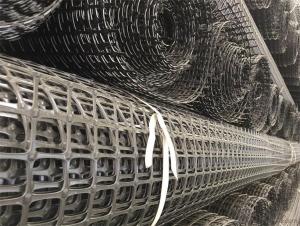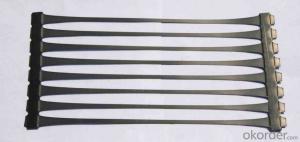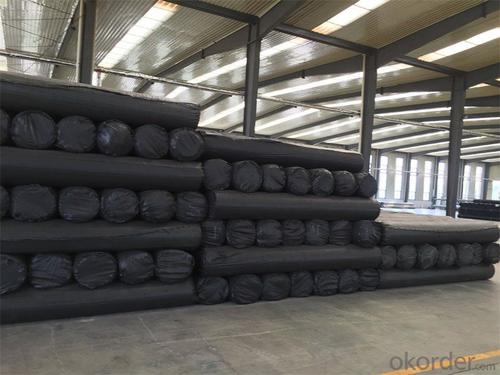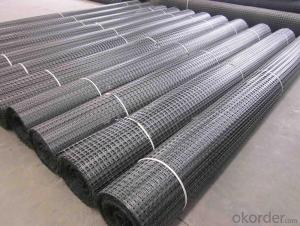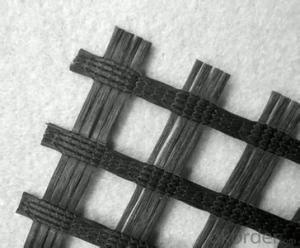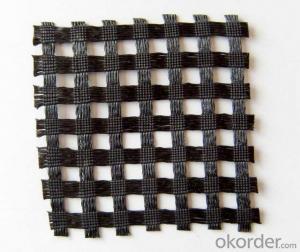Tenax Lightweight Geogrids for Civil Engineering Construction
- Loading Port:
- China main port
- Payment Terms:
- TT OR LC
- Min Order Qty:
- 1000 m²
- Supply Capability:
- 10000000 m²/month
OKorder Service Pledge
OKorder Financial Service
You Might Also Like

Introduction
Geogrid is widely used in civil construction over the whole world. It is manufactured on the basis of high-impact polyethylene and polypropylene. Geogrids are used as reinforcement materials on mellow soils for railway and car roads, parking places, landing grounds and for the reinforcement of bridge piers, slopes and earth banks, for erosion protection of slopes.
1)fiberglass geogrid with CE certificate
2)Materials:fiberglass
3) Tensile strength:MD/CD:30 ~ 200kn/m
4)WIdth:1 ~ 6m
Temperature Resistance (Centigrade): -100~290
Surface Processing: Modified asphalt or Polymer and self adhesive
Packing: With PE bags
Our Service
Quality assurance
1.On a regular basis or as per your request,we entrust national testing agencies to conduct quality inspections
2. Strictly in accordance with the ISO9001-2008 international quality system standard,we monitor and manage the whole process throughout production,quality testing,and measurement to ensure product quality
3. For quality-related construction delay or substandard construction(except for damage or losses due to customer’s responsibility or irresistible natural disasters),we have refunding,replacement,and repair services.We will respond to customers’ feedbacks on quality issues within 24 hours.
Packaging & Shipping
Packing: PLASTIC FILM INSIDE, AND WOVEN BAG OUTSIDE
Shipping: About 15 days after receipt the deposit
FAQ:
Q: What kind of payments does jenor support?
A: T/T, L/C, Cash are accepted.
Q: Do you charge for the samples?
A: Accordeing to our company policy, the samples are free, we only charge the freight fee. And we will return the freight fee during the next order.
Q: Can you produce according to customers' design?
A: Sure, we are professional manufacturer, OEM and ODM are both welcome.
Q: Do you have other products?
A: Yes, please check the pictures:
- Q: What is the action mechanism of OKorder geogrid
- Glass fiber geogrid / glassgrid mechanism of reflective cracking is due to the old concrete surface layer in the vicinity of the joint or crack of large displacement caused by the asphalt overlay above appear stress concentration caused by the. Glass fiber geogrid has been developed rapidly in recent years, and is widely used in asphalt pavement, especially used in asphalt overlay to reduce reflection cracks. Texas Traffic College of AM University in Canada with its unique overlay tester of glass fiber geogrid reinforced cover did a lot of tests and experiments show that the reinforced asphalt specimen cracking resistance than the unreinforced specimens two times. Wollongong Municipal Bureau of New South Wales, Australia has conducted on-site tests of glass fiber geogrid, PP geogrid, geotextile and thickness of asphalt concrete surface layer of reflection crack control products, the conclusion is glass fiber geogrid laying convenience, control effect of reflection crack is the most significant, and the cost is moderate. Therefore we should promote the application. Due to the reinforcement effect of glass fiber geogrid on asphalt overlay, so it can be in the premise of effective control of reflection cracks, reduce the asphalt overlay thickness (with and without laying fiberglass geogrid, compared) reduce the cost, and achieved good economic benefit.
- Q: What is the effect of polymer type on geogrid behavior?
- The effect of polymer type on geogrid behavior is significant as it determines the strength, durability, and overall performance of the geogrid. Different polymers have varying tensile strength, elongation characteristics, and resistance to environmental factors such as UV radiation and chemical exposure. Therefore, the choice of polymer type directly impacts the geogrid's ability to provide reinforcement, soil stabilization, and load distribution in geotechnical applications.
- Q: How much is the tensile strength of geogrid???????
- Divided into three categories: the overall plastic stretch: two-way products: 15KN--50KN one-way products: 50KN---300KN
- Q: Can geogrids be used in ground stabilization for telecommunications infrastructure?
- Yes, geogrids can be used in ground stabilization for telecommunications infrastructure. Geogrids are commonly used to reinforce soil and provide stability to various types of infrastructure, including telecommunications installations. They can effectively distribute loads, prevent soil erosion, and enhance the overall strength and stability of the ground.
- Q: Can geogrids be used in ground improvement projects?
- Yes, geogrids can be used in ground improvement projects. Geogrids are commonly used to reinforce and stabilize soil, improving its bearing capacity and preventing soil erosion. They are effective in a variety of ground improvement applications such as road construction, retaining walls, and slope stabilization.
- Q: Do geogrids provide reinforcement to geosynthetic asphalt liners in reservoirs?
- No, geogrids do not provide reinforcement to geosynthetic asphalt liners in reservoirs.
- Q: How do geogrids improve the stability of embankments?
- Geogrids improve the stability of embankments by providing additional reinforcement to the soil. They are made of high-strength materials and are placed within the soil layers to distribute the load more evenly. Geogrids increase the friction between the soil particles, preventing excessive movement and settlement. This reinforcement helps to resist the forces of gravity and external loads, ultimately enhancing the overall stability and longevity of the embankment.
- Q: And specification.. Thank you for answering me
- In order to achieve an asymmetric competitive advantage, now the problem of engineering design is really big, institutional problems
- Q: Are geogrids suitable for railway track stabilization?
- Yes, geogrids are suitable for railway track stabilization. Geogrids provide effective reinforcement and stabilization to the track structure, improving its durability and resistance to deformation caused by heavy train loads. They enhance the load-bearing capacity of the track and prevent the formation of track deformations such as rutting and settlement. Moreover, geogrids help in distributing the load more evenly, reducing the stress on the underlying soil and improving overall track performance.
- Q: Are geogrids suitable for use in ground reinforcement for residential developments?
- Yes, geogrids are suitable for use in ground reinforcement for residential developments. Geogrids provide effective soil stabilization and reinforcement, enhancing the stability and load-bearing capacity of the ground. They are durable, cost-effective, and can be easily installed, making them a practical choice for residential projects.
Send your message to us
Tenax Lightweight Geogrids for Civil Engineering Construction
- Loading Port:
- China main port
- Payment Terms:
- TT OR LC
- Min Order Qty:
- 1000 m²
- Supply Capability:
- 10000000 m²/month
OKorder Service Pledge
OKorder Financial Service
Similar products
Hot products
Hot Searches
Related keywords
